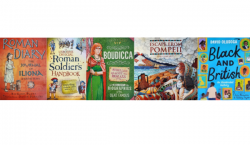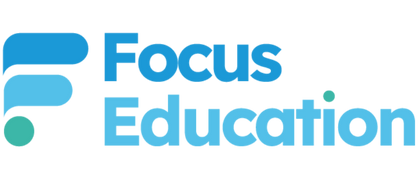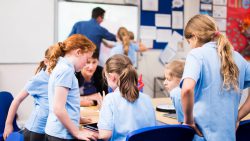 ‘Things always seem to go round in a circle in education.’ These are the words that I heard so many times when I was an NQT (or ECT now), from more experienced staff members or when I went on courses. To some extent, this is true. There are things that come up and then disappear, but I think with the development of social media and how much more interconnected teachers are, the sharing of research and development has improved so much that we are hopefully seeing fewer of these ‘fads’ coming and going and then returning again.
‘Things always seem to go round in a circle in education.’ These are the words that I heard so many times when I was an NQT (or ECT now), from more experienced staff members or when I went on courses. To some extent, this is true. There are things that come up and then disappear, but I think with the development of social media and how much more interconnected teachers are, the sharing of research and development has improved so much that we are hopefully seeing fewer of these ‘fads’ coming and going and then returning again.
One of the aspects of teaching that I think has come and gone and then returned again is the principal of teaching through a topic. It is also one of the things that I have loved developing as a teacher, developing my knowledge of books that I can use to teach both my ‘topic’ lessons and my English lessons. These books then also feed into other areas of the curriculum, whether its linking creative ideas for art and design or inspiring science investigations. Now I have often seen arguments about how books are used, on twitter (X) or Facebook, and it often starts with something like ‘don’t just use a book because it links to a topic’ and it moves on to ‘use a book because it’s a good book’, or ‘don’t shoehorn books into learning that don’t fit’. I actually agree with all of these views. However, I think if you know your books, you can build a curriculum around them, which does all link together. I also think that linking these books through your topics is extremely important too. Developing a curriculum in a Primary school is like putting the pieces of a puzzle together, and there are different ways of approaching this, but ultimately, it all has to fit in the right way for the children that you teach.
Curriculum drivers
The drivers for developing a Primary school’s curriculum are often centred around history and geography. I think this is a natural approach to take because there are so many links that you can make from a history topic about the Romans in Britain or a geography topic studying extreme weather. I’ve also talked about the substantive concepts in history in a previous blog, but this is relevant here too. The concepts of chronology, cause and consequence, similarity and difference, continuity and change, and significance, are all relevant in other areas of the curriculum. This is similar with many of the substantive concepts in geography, particularly when you are encouraging children to understand the world that they live in; knowing the physical geographical features and the human geographical features of where they live and the wider world around them is so important and relevant to other areas of the curriculum. Science is another area which can drive curriculum development, and this often works because of the links between the nature of the three areas. They compliment everything else and it makes sense to utilise this.

A good example of using these three subjects as curriculum drivers is the ‘Learning Challenge Curriculum’ because history, geography and science are exactly what it is built around. And these subjects are its main drivers because they promote developing enquiry and investigative skills that should be at the heart of learning. If we can encourage children to ask more perceptive questions and answer them by becoming more informed through their developing understanding, then you are building a curriculum that is focussed on developing life-long learners. Children will be obtaining knowledge and skills that they are able to apply within and across different contexts.
How children learn
As educators, our focus always has the children at its heart, and in particular we have to consider how children learn. Metacognition often comes up in discussion, and it’s really important that we understand how the children we teach learn best and develop our curriculum and approach to teaching and learning in a way that maximises this. There are many underlying principles that we can follow, but ultimately, we have to really know our children within our setting. We want to set children up so that they are continuously developing their ability to commit more knowledge to their long-term memory. This is why your curriculum drivers are so important.
When developing a school’s curriculum, we want to build in as many opportunities as possible for the children to revisit the knowledge and skills that they have or are developing. This might be through retrieval practice, and building in these opportunities to revisit learning within your curriculum is a really important piece of the puzzle. That means that it is no good teaching something in Year 1 and then never considering it again. Imagine if you applied this to a concept in maths, for example, like time. If you taught your class to tell the time in Year 1 (which would be a really tough challenge as they’ve probably barely experienced times on a clock much before this point) and then never look at time again throughout primary school, we would have children who cannot tell the time when they attend secondary school. Now I know that this seems an obvious thing to point out, but if we are developing a curriculum as a whole, then it makes absolute sense to use history and geography as drivers because we can make so many links between them and other areas. Sticking with time as an example, in geography you need children to look at different time zones in Key Stage 2. I’ve not even had to think particularly hard to make that link. Also, as a concept, chronology always links to time, and so its applicable to history learning too.
Books, books, books!
So much of our curriculum is dependent on developing speaking and listening, reading and writing skills, and so books must be at the heart of it. And I mentioned initially the discussions that educators often have about not using a book just because it links to a topic. But having used texts that link to topics throughout the last 14 years of my career I feel that the range of books that are available at our fingertips now means that it is so straightforward to identify and get hold of fantastic books that we can use in English lessons that then link to history and geography ‘topics’. If we use the Romans as an example, there are some fantastic books, such as these below:

Roman Diary is great for considering what life was like in Roman times, and is written from the point of view of a little girl who has become a Roman slave. It’s great for inspiring diary writing. The Roman Soldier’s Handbook gives so much information about what it was like to be a Roman soldier. This can be linked to non-fiction writing and lends itself amazingly well to this. In Black and British, David Olusoga includes information about black people who lived in Roman Britain, and the children can research this and write reports on the presence of the Romans in Britain. When we talk about the Roman impact on Britain, it’s impossible to ignore the story of Boudicca, and this lends itself to biographical writing. Escape from Pompeii is another fantastic book which not only links to teaching about the Romans but also the impact of volcanoes on a locality.
I know that I have just listed how I have used these books, but it’s so important to make links through reading and writing lessons because what we are trying to do is build in as many points in the curriculum as possible where the children can revisit knowledge and build on it further. It’s also extremely important to use English lessons in this way because the time each week that is designated for history, geography and other foundation subjects is really limited. This doesn’t mean that we cannot or should not use other books that don’t relate to topics. We absolutely can and should, as it’s another vehicle for presenting children with opportunities to apply prior learning within a new context. But by creating links across the curriculum in the way we develop it, we are ensuring that the children are given every opportunity to cement knowledge within their memory. We are also providing them with multiple opportunities to recall and deploy their knowledge, which is exactly what we want to achieve.
Curriculum development in primary schools is all about piecing the puzzle of the curriculum jigsaw together so that we are maximising the opportunities we have to ensure that children learn in a way that builds their knowledge up. Using areas such as history and geography in this way to construct a curriculum that builds on prior knowledge and makes links across the curriculum is something that is really important. If we are clever with the topics we choose to develop, and the texts we choose to use as examples and models, we can provide the children we teach with exciting and engaging opportunities for developing their own learning – which is why we are here!
Continue the Conversation
For more information about our flagship Learning Challenge Curriculum, you can visit our website here
Learning Challenge Curriculum
You can find us on Twitter @FocusEd_LCC or get in touch with the Focus Education office on 01457 821 818.
History Units of Learning, eBook – £25.00Related Products
![]()






